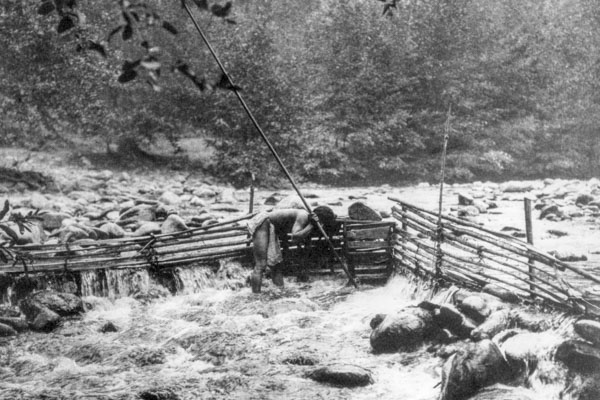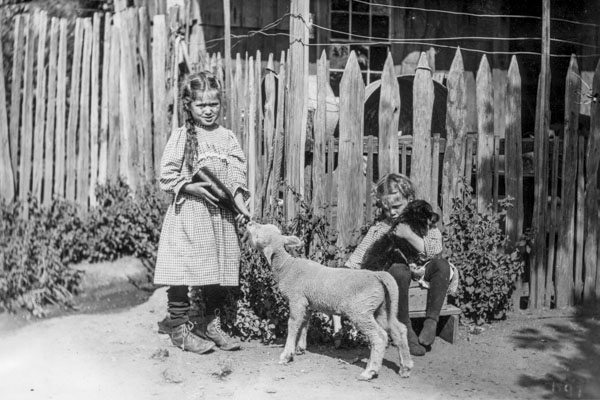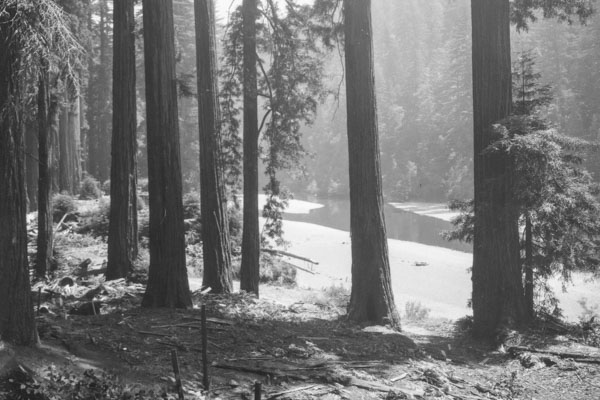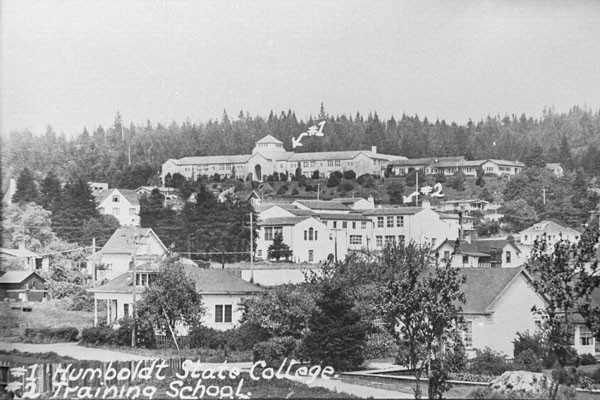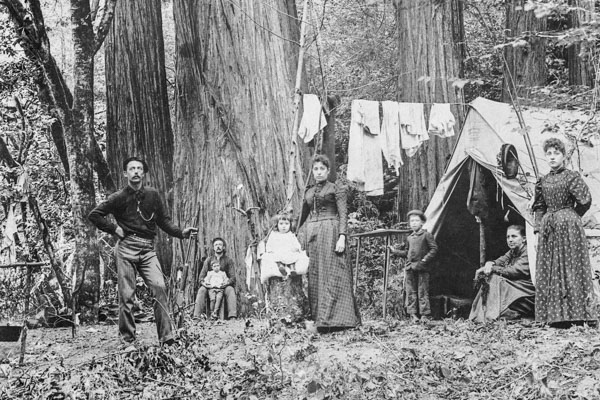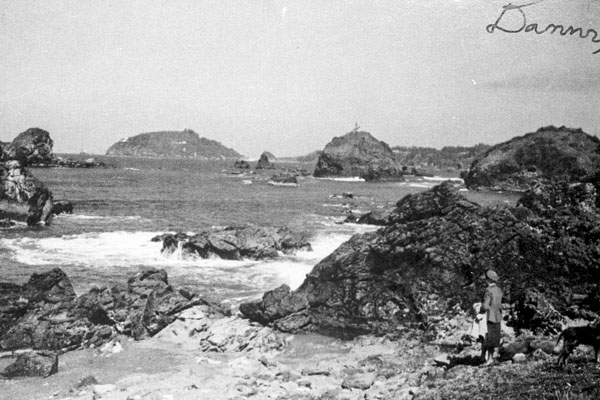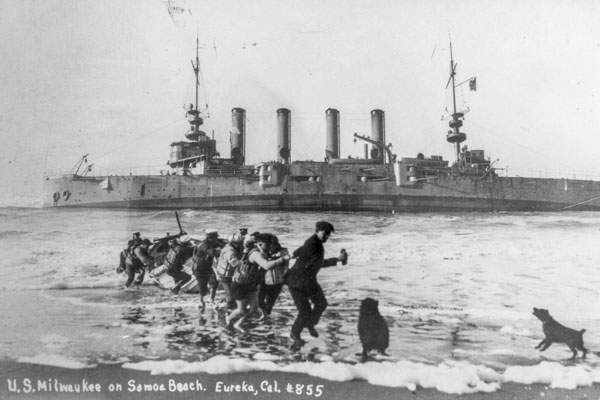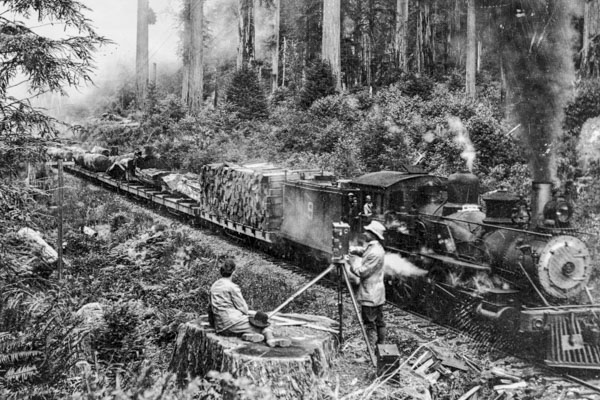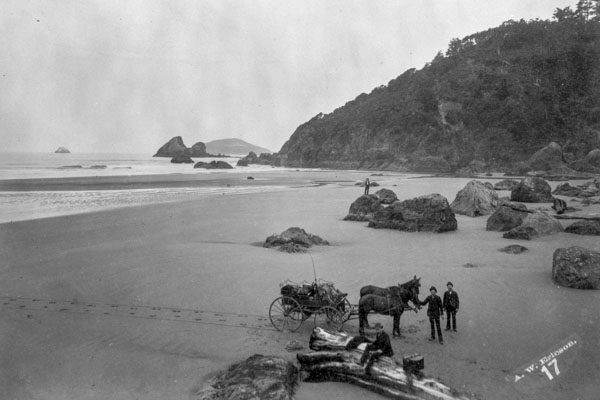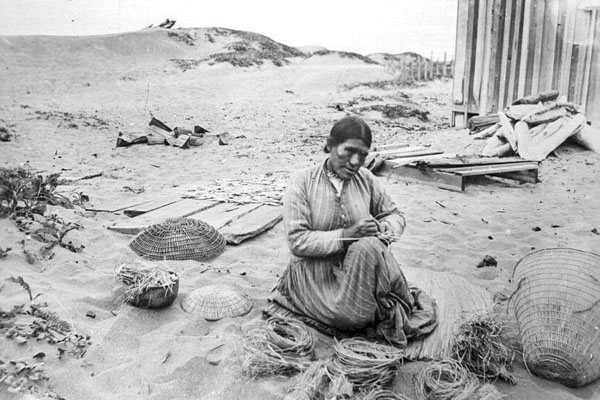You are here
History of Humboldt County Newspaper Enterprises by W.W. Elliott
Elliott, W.W. and Co. 1881 "History of Humboldt County Newspaper Enterprises", pp. 215-218.
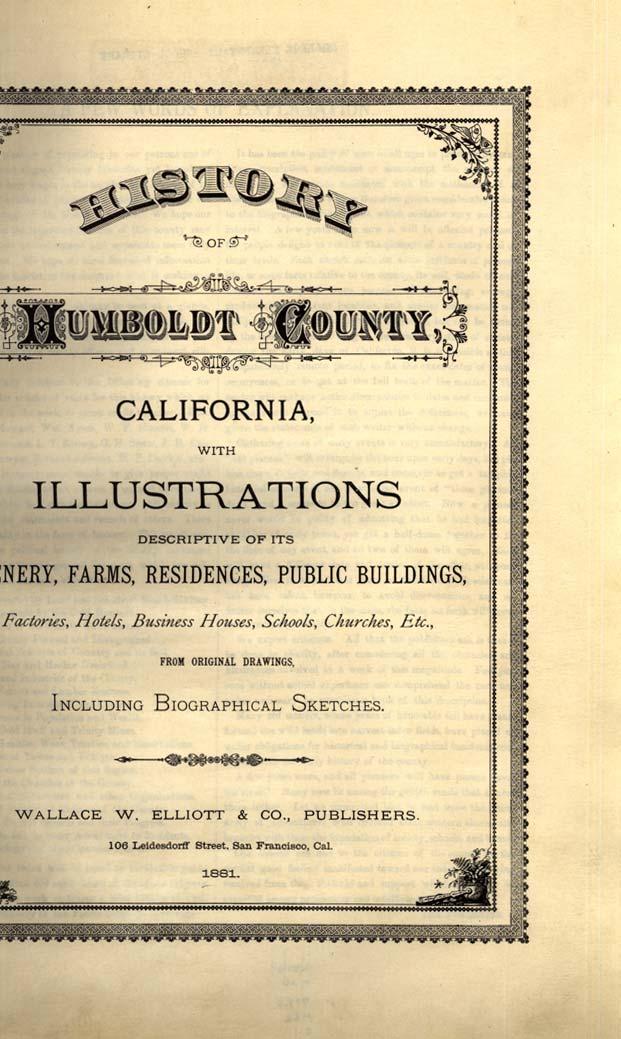
First Newspapers, Failures and Triumphs, List of Papers of Humboldt County from 1854 to 1882
Early in the year 1853, among the few who endeavored to form a settlement and build up Humboldt County, came Dr. E.D. Coleman. He was a man of nerve and ability, possessed of a good education and a literary turn of mind. Union, now Arcata, and Eureka grew rapidly, the former taking the lead and holding it for some years. When the prospects for Union were the brightest, when the tide of immigration had set northward and was fast flowing into Humboldt Bay, Dr. Coleman conceived the idea of starting a newspaper and furnish reading matter for the inhabitants of northern California. With every fresh influx of people the more favorably did he look upon the matter, until he determined to put his plan into execution, and on the second day of September, 1854, he presented to the people of Humboldt County the initial number of
The Humboldt Times.
As Eureka was the most central point the paper was published at that place. The commercial, agricultural and mining interests of this section were then in their infancy, in fact barely opened. The harbor was second only to that of San Francisco, from Panama on the south to the Straits of Fuca on the north. Steamers entered the port on an average of once a month, and mail facilities were little better than none at all. With all conceivable obstacles before him, the Dr. began his task. The Times was independent in politics, and was devoted purely to the interests of the people. It was ably edited, its columns well filled with choice reading matter, and its typographical make-up excellent. Toward the close of the year, Union had made such rapid advancement and attained such proportions, the county seat being located there, the Times was moved across the bay and published at Union, December 23, 1854.
On the 22d of December, 1855, E.D. Coleman sold out the Times to Walter Van Dyke and Austin Wiley, the former taking editorial charge, the Doctor taking his departure from the county and locating at Washington, D.C. These gentlemen carried on the paper until January 23, 1858, when W. Van Dyke transferred his interest to A. Wiley, the junior partner, and again took up his profession, that of attorney-at-law.
As time rolled on the business interests experienced a change of base. The great timber resources were being opened on a large scale. Mills for manufacturing lumber were established at Eureka; the county seat was removed from Union to Eureka; it was made the principal shipping point, and immigration and the increase of business caused the village to make rapid strides in the march of progress and take upon itself the habiliments of a town. The business finger indicated Eureka as the objective point, and at the close of the fourth volume Mr. Wiley moved the Times office back to Eureka August 28, 1858, where it has been published without an omission up to the writing of this. June 9, 1860, Mr. Wiley transferred the paper to Walter Van Dyke and L.M. Burson.
In 1858, when the Times was moved from Union the citizens of that place were in no manner of means pleased with the change, and at once made arrangements for the publishing of another paper. Accordingly, on the 15th of December, 1858, the Northern Californian made its appearance with S.G. Whipple as editor and proprietor. After running about eighteen months, the owners were satisfied that there was neither business nor patronage in the county sufficient to warrant the publication of two papers and the Californian was merged into the Times, July 14, 1860, L.M. Burson withdrawing from the last-named paper and S.G. Whipple associating himself with Walter Van Dyke as publishers of the Times. The paper was carried on by the two gentlemen above named until March 30, 1861, when W. Van Dyke withdrew, having transferred his interest to S.G. Whipple. August 16, 1862, Mr. Whipple sold out to A. Wiley and Walter Bohall, Mr. Wiley again taking charge as editor. In April, 1864, Mr. Wiley having been elected to represent Humboldt County in the Legislature, J.E. Wyman was placed in charge of the editorial columns, the ownership remaining the same, and on the 27th of May Mr. Wiley transferred his interest to J.E. Wyman, the firm being Wyman & Bohall. August 19, 1865, J.E. Wyman purchased Mr. Bohall's interest.
Business, which at that time was at a standstill, soon began to pick up and improve. A large number of people settled in the county, new industries were opened up, and the march of progress was onward and upward. The mail facilities were greatly improved, lines of steamers were placed on the route between the bay and San Francisco, and an era of prosperity was inaugurated. Under the management of J.E. Wyman, the Times was Republican in politics, and pursuing a consistent course, steadily worked into the good graces of the people. In 1873 a telegraph line was built from Eureka, connecting with the Western Union at Petaluma, and arrangements were made by J.W. Wyman to publish a daily paper at Eureka. The line was completed and in working order the latter part of the year.
Daily Humboldt Times.
First number was issued January 1, 1874. For protection, as well as to be placed in a position to receive the latest and most reliable news from all parts of the world, the Times joined the Associated press, and received all dispatches from that source.
On the 1st of January, 1875, W.H. Wyman, a son of the proprietor, was taken into the business, and the firm was from that time known as J.E. Wyman & Son. The Daily Times rapidly grew in favor, and from time to time was enlarged to suit the increasing business. November 5, 1880, J.E. Wyman, the senior partner, who had been connected with the paper since 1864, died, and in September, 1881, W.H. Wyman assumed entire control, and is at the present time publisher and proprietor.
The Humboldt Times is one of the oldest papers published on the coast, and has a complete file of the publication from the first issue, which is in itself a valuable record and a correct history of the current events that have transpired for over a quarter of a century. It has sailed the sea that all journals have to cross; it has met adverse winds, and encountered heavy swells; it has suffered strong opposition, but pursing a straight-forward, honorable course, it is now the exponent of the people of Humboldt County, and ranks among the leading interior papers of the State. A large amount of capital has been invested in the businesss; it is supplied with steam power, power presses, etc, and is complete in every respect.
Other Journals.
Since the county was organized a host of papers have been started, but most of them failed to make the business pay, and one by one they, like the rose, withered and died.
One of the early papers was the Sluice Box, published at Orleans Bar in 1856, by Frank Ball. The first numbers were filled with local hits and humorous illustrations.
View of Klamath County Jail.
One of the illustrations in the Sluice Box was entitled "A View of Klamath County Jail, erected in 1832, built of oak wood." The picture was a sketch of a large oak tree, with a staple and chain attached. It represented two verdant sons of Erin who were indicted for jumping Chinamen's claims, and were handcuffed and fastened to said jail by means of the chain. It seems they were victims of "misplaced confidence," having surrendered themselves on the supposition that the county had no jail, and expected that the sheriff would board them at the hotel. They were ready to plead guilty and make amends after being out all night.
December 1, 1856, the publisher of the Sluice Box determined to discontinue his little sheet which had become a great favorite with its readers. In his valedictory he says: "Our work is done, our mission is ended, and now with a clear conscience and dust in our pockets, we vacate the editorial chair and retire to the shades of private life." He asked no odds of the public and no thanks to render for past favors. Hear him: "Perhaps, dear public, you think we ought to thank you for your liberal support and for paying us so promptly. Not a bit of it. The boot is on the other foot, and you know it. You know very well that we did not start it to make money or gain a livelihood, but for our own pleasure, nevertheless you bought it, and for a wonder paid for it, and got your money's worth, and we hope will profit by the advice we have given you from time to time." He takes his final leave after this fashion: "And now, dear public, we must close. If we have hurt any one's feelings, we forgive 'em; if we have done any person injustice, we will accept their apologies, and hoping the Lord will take a liking to you, we bid you a last farewell."
Various Journals Started.
The Northern Californian was published at Union, in December, 1859, by S.G. Whipple, and merged into the Times, July 14, 1860.
The Casket was started in Arcata in 1860, but was issued for only a short period.
The Humboldt Bay Journal, Democratic in politics, was first published September 1, 1865, Rev. J.W. Hines, editor. In December of the same year the editorship passed into the hands of J.B. Baccus, Jr., who conducted the paper until the time of its demise, April 20, 1867.
The Humboldt Bay Democrat began its career October 24, 1868, with L.M. Music & Co. at the head, and lasted three weeks.
The National Index, Democratic, appeared June 27, 1867, and suspended March 14, 1868.
The Northern Independent was laid before the public July 22, 1869, A.M. Parry, publisher. The tone of the paper was Independent, with Democratic tendencies. Later on the paper passed into the hands of Eugene Russ, who carried it on until August 15, 1872, when the obituary was pronounced.
The West Coast Signal, D.E. Gordon, editor and publisher, appeared February 15, 1871. It was Independent in politics, with Republican leanings. October 7, 1876, the Daily Evening Signal made its appearance. The Signal, as a daily and weekly, was published by Mr. Gordon until March 17, 1880, when it suspended.
The Age, a small daily paper, was started in 1876, by W.H. Clipperton, as a free advertising sheet, but failing to make it pay, it was suspended. The material was purchased by J.A. Betteridge, and after refitting the office Betteridge & Sinnerton, December 23, 1876, commenced the publication of the Evening Star as an advertising sheet. Afterwards a regular price was charged for subscriptions, and April 20, 1878, publication was suspended.
The Evening Herald commenced publication March 22, 1879, W.B. Thorpe, proprietor. The paper was issued only a few months, when the office was removed to Arcata.
The Leader was commenced at Arcata, August 2, 1879, by W.B. Thorpe. Shortly after the close of the first volume the paper suspended, the editor moving away from the county. December 11, 1880, it was revived, Austin Wiley taking charge. It was published one year and again suspended.
The Eel River Echo was commenced by W.H. Runnels at Rohnerville, in 1878, and after nearly two years' struggle, was compelled to suspend. The material was moved to Eureka, where A.J. Bledsoe commenced the publication of the semi-weekly News in 1881. The News suspended after being in existence three months.
Ferndale Enterprise.
This paper, a seven-column folio, 24x36, was established May 11, 1878, by W.G. Jones & Co. The Enterprise was an outgrowth of the indomitable spirit of energy that has ever characterized the citizens of Ferndale and Eel River Valley in their determination to be surpassed by no other portion of the county. The paper, though founded by inexperienced and youthful men, soon became a power in the county and did much toward demonstrating the possibility of navigating Eel River entrance by ocean steamers. It has labored unremittingly to advance the material interests of southern Humboldt and always has been found with the people in all vital questions of civil or religious polity, numbering among its supporters men of all parties and of all sects. November 19, 1880, the firm of Jones & Co. was succeeded by the present proprietor, F.A. Alford. He, also a novice, being by profession a physician, a graduate from the noted school of Bellevue Hospital Medical College, New York City, in 1869, brought new life and vigor to the Enterprise. Almost immediately a Gordon job press and full outfit of job type were added, and other important changes made in the office and in the paper. The business was reduced to a system under the new regime, the most important feature being the collection of all bills the first of each month, by a regular collector. No dead advertising matter has been allowed to remain in its columns under any circumstances. It is well supported by home and foreign advertisements, being recognized as occupying a field unfilled by any other publication, supplying a section some fifty miles square. Independent in politics, the editorials are always outspoken on all questions of interest, and aim to be radical in their conservatism. The locals have made the paper a recognized standard for local and county news, doubling the circulation in a year, which now averages about 800. January 1, 1882, the office was removed to a building of its own, and fitted up with every convenience. It is now situated south of the Pioneer Livery Stables, on Main Street, and presents a handsome font, twenty-eight feed in width. It occupies rooms 16x32 feet, and 12x20 for composing and press rooms and offices. The first papers from the new quarters was issued January 6, 1882, and is a fair specimen and representative papers of southern Humboldt.
The Democratic Standard.
The Weekly Standard was established in June, 1875, by R.V. Cladd & Co. In June, 1877, it was purchased by the present publisher, William Ayers, Esq., who shortly afterwards changes its title to "The Democratic Standard."
In the spring of 1878, it commenced the discussion of the greenback financial doctrine, to which it has adhered ever since, being the first greenback paper published in California. The main feature and effort of the paper has been the description of the various sections of the county, together with the discussion and agitation of bay and harbor improvements. In this self-allotted task it has been untiring, letting no opportunity pass that would serve to give the subject a fresh stirring up.
It is a representative northern California paper, gleaning all important items from the northern tier of counties into its columns. Its publisher makes it a point to travel over some portion of the territory it serves, every year, to study the country, its needs and capabilities, and get acquainted with its inhabitants.
The ultimate aim of the Standard is to leave no stone unturned in the effort to make Eureka the port of supply, export and import, for the whole section of country in semi-circle from 100 to 150 miles surrounding Humboldt Bay. From its columns we have gathered much valuable information, used in compiling this History.
Daily and Weekly Telephone.
The Telephone was first issued December 21, 1881, by Messrs. Wiley & Heney, proprietors. It is 21x28 inches in size, with six columns on a page. It is the most complete daily paper ever published in the county. Its initial number contained seventy-two local paragraphs, all of them readable and newsy. The firm has made an independent telegraph arrangement, and has secured the services of a competent telegraphic correspondent in San Francisco.
It has daily and weekly editions. A. Wiley was associated with Walter Van Dyke twenty-six years ago on the Times. The publishers are practical newspaper men and very well know how to manage and make a successful journal. It is bright, and keeps up with the demand for local items and late news.
Rohnerville Herald.
The publication of the Herald was commenced at Rohnerville, Humboldt County, on the 2d day of November, 1881, by Charles W. Gordon, at the age of 19 years, who had been a resident of the county since 1872. The people of Rohnerville demanded a newspaper, and the present publisher took advantage of the opportunity, and has found the venture a successful one. The subscription list had reached nearly 450 on the 1st day of March, and the paper shows a very liberal advertising patronage. It is the official organ for publication of land notices in eastern and southern Humboldt and is published at $1.50 a year. The publisher declares his paper to be Independent-Republican. It is a creditable paper, and does honor to the people of Rohnerville and vicinity, who are determined to have a paper of their own in which to set forth the advantages of that prosperous village.
JOURNALISM OF DEL NORTE COUNTY.
Just after Crescent City sprang into existence, on June 10, 1854, was issued the first number of the Herald, which for seven years was a weekly visitor to its friends, and a vigilant and earnest factor of the growth and welfare of this section of California.
The press and material were shipped from San Francisco by the editors and proprietors, Messrs. B.Y. Fechtig and U.B. Freanor. It was a twenty-column paper, published weekly, at a subscription price of ten dollars per annum. The very first issue contained an article upon the subject of a wagon road to connect this place with southern Oregon - a question which still gives rise to discussion. It professed to be "independent" in politics, but really had a very decided Democratic inclination. In September, 1854, Mr. Fechtig withdrew, and S.H. Grubler assumed his place. Under the new management the tone of the Herald was unaltered. The last issue by Grubler & Freanor was June 4, 1856, when T.S. Pomeroy entered the partnership and took editorial charge. This co-partnership continued until August 19, 1859, when Freanor withdrew, and the paper remained in the exclusive control of the latter. He continued at its head until the completion of its seventh volume, June 8, 1861, when he removed to Jacksonville, Oregon, with the entire office.
T.S. Pomeroy came to Crescent City in 1853 as Clerk of Klamath County, when the seat of Government was removed to this place. In 1856 he was appointed County Judge to fill a vacancy. In 1861 he established in Jacksonville the Southern Oregon Gazette, in connection with O'Meara, now of the San Francisco Examiner. This was in the dark days when the Union toppled upon its foundation. The Gazette was too pronouncedly "Secesh," and was refused admission to the mails. This action of the Postmaster General ended its life. After a lingering and painful illness he died here. He was an active positive man of many virtues and few faults.
The Crescent City Courier issued its first number September 12, 1872, with Walter B. Thorpe as editor and proprietor. Under his management the Courier flew the Republican colors, and was the only paper that has ever in Del Norte assumed openly the partisanship of any political party.
In his issue of March 7, 1874, he announced the sale of the paper and bid an affectionate adieu to the scenes of his early life. From here he went to Eureka, and subsequently to Arcata, where he established the Arcata Leader, but sold his property there and went to Sacramento, and thence to Washington, D.C. At last accounts he was still at the National Capitol. On the 14 of March, 1874, without interruption, the Courier appeared with Mason & Tack as proprietors, the former, Wm. B. Mason, making the editorial salutatory and introduction. This firm was beyond question the strongest that has solicited support for a paper in Del Norte. Both were typographers and neither was unfamiliar with pencil and scissors. Both had and still have, a large circle of warm, sincere friends.
Wm. B. Mason, the senior partner, spent nearly all his life in Crescent City, and has led a life such as is seen only in the shifting scenes of a "far West." A school boy here of long ago, he has grown to man's estate with many of its virtues and none of its vices. Frequently, in various capacities, has he been called upon as a servant of the people, the last time being as Assemblyman from this county to the Legislature of 1879 and 1880, to which he was elected as a straight Republican.
On the 12th of November, 1879, Silas White resumed the publication of the Courier which he continued until the 9th of February, 1881.
The Del Norte Record was first started as a free monthly, April 19, 1879, by J.E. Eldridge, and was published weekly, beginning May 13th, and in September of that year it was slightly enlarged. With the second volume, May 8, 1880, the paper was enlarged to its present size, twenty-eight columns. On the 5th of February, encouraged by success thus far and the business prospects of the future, the Courier was bought and consolidated with the Record after its last issue on the 9th. The editor does not feel that the field of his labors warrants the advocacy of any set of party tenets and still abstains from the expression of party views, and has taken up the cudgels neither for nor against opposing factions nor men.
The paper is a valuable sheet. The editor came here many years ago, and has grown grey as the town matured in years.
Browse Articles | NCN Homepage | NCN Sitemap
The Northwest California Newspapers Website is managed by Special Collections located in the Cal Poly Humboldt Library.
